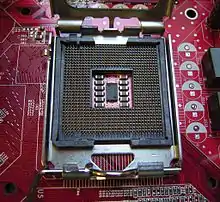Land grid array
The land grid array (LGA) is a type of surface-mount packaging for integrated circuits (ICs) that is notable for having the pins on the socket (when a socket is used) rather than the integrated circuit.[1] An LGA can be electrically connected to a printed circuit board (PCB) either by the use of a socket or by soldering directly to the board.

Description
The land grid array is a packaging technology with a rectangular grid of contacts, 'lands', on the underside of a package. The contacts are to be connected to a grid of contacts on the PCB. Not all rows and columns of the grid need to be used. The contacts can either be made by using an LGA socket, or by using solder paste.[2]
LGA packaging is related to ball grid array (BGA) and pin grid array (PGA) packaging. Unlike pin grid arrays, land grid array packages are designed to fit either in a socket, or be soldered down using surface mount technology. PGA packages cannot be soldered down using surface mount technology. In contrast with a BGA, land grid array packages in non socketed configurations have no balls, and use flat contacts which are soldered directly to the PCB. BGA packages, however have balls as their contacts in between the IC and the PCBs. The balls are normally attached to the underside of the IC.
Use in microprocessors
LGA is used as a physical interface for microprocessors of the Intel Pentium, Intel Xeon, Intel Core and AMD Opteron, Threadripper and Epyc families. Unlike the pin grid array (PGA) interface found on most AMD and older Intel processors, there are no pins on the chip; in place of the pins are pads of bare gold-plated copper that touch protruding pins on the microprocessor's connector on the motherboard. Compared to PGA CPUs, LGA reduces the likelihood of the chip being damaged either before or during installation as there are no pins that can be accidentally bent. By transferring the pins to the motherboard, it is possible to design the socket to physically shield the pins from damage, and the costs of installation damage can be mitigated as motherboards tend to be significantly cheaper than CPUs.[3]
While LGA sockets have been in use as early as 1996 by the MIPS R10000 and HP PA-8000 processors, the interface did not gain widespread use until Intel introduced their LGA platform, starting with the 5x0 and 6x0 sequence Pentium 4 (Prescott) in 2004. All Pentium D and Core 2 desktop processors use LGA 775 socket. As of Q1 2006, Intel switched the Xeon server platform to LGA, starting with the 5000-series models. AMD introduced their server LGA platform starting with the 2000-series Opteron in Q2 2006. AMD offered the Athlon 64 FX series on socket 1207FX through ASUS's L1N64-SLI WS motherboards. It was the only desktop LGA solution offered by AMD.
The most recent Intel desktop LGA socket is dubbed LGA 1200 (Socket H4), which is used with Intel's Comet Lake series Core i3, i5, and i7 families, as well as their lower-end Pentium and Celeron families. Their Skylake-X Core i7 and Core i9 families use the LGA 2066 socket. The LGA setup provides higher pin densities, allowing more power contacts and thus a more stable power supply to the chip.
AMD introduced its first consumer LGA socket, called Socket TR4 (LGA 4094) for its high end desktop platform Ryzen Threadripper processors. This socket is physically identical to their Socket SP3 for their Epyc server CPUs even though SP3 CPUs are not compatible with the desktop X399 chipset and vice versa.
The previous AMD server LGA socket was designated Socket G34 (LGA 1944). Like Intel, AMD decided to use LGA sockets for their higher pin densities, as a 1944-pin PGA would simply be too large for most motherboards.
AMD
- Socket F (LGA 1207)
- Socket C32 (LGA 1207) (replaces Socket F)
- Socket G34 (LGA 1944)
- Socket SP3 (LGA 4094)
- Socket TR4 (LGA 4094)
- Socket sTRX4 (LGA 4094)
Intel
- LGA 771 (Socket J) – Note that Socket 771 is the server counterpart of LGA 775 and with a bus compatible motherboard, an adapter for LGA 775 to LGA 771 can be used to get a Xeon on a consumer motherboard with Socket 775.
- LGA 775 (Socket T)
- LGA 1366 (Socket B)
- LGA 1356 (Socket B2)
- LGA 1156 (Socket H)
- LGA 1155 (Socket H2)
- LGA 1150 (Socket H3)
- LGA 1151 (Socket H4) – note that two discrete revisions of LGA 1151 exist; the first revision is only compatible with Skylake and Kaby Lake CPUs while the second revision is only compatible with Coffee Lake CPUs.
- LGA 1200 (Socket H5)
- LGA 2011 (Socket R)
- LGA 2011-3 (Socket R3) – note that LGA 2011-3 is incompatible with LGA 2011 and is used for Haswell-E and Broadwell-E Intel Core i7 extreme processors and the Intel X99 chipset. It does, however have the same pin count and design as LGA 2011. Also used for Xeon E5 processors and Intel C612 chipset.
- LGA 2066 (Socket R4) – for Intel's X299 Chipset and i5, i7 and i9 X processors from Skylake-X and Kaby Lake-X lines. There are Xeons also available for this socket.
- LGA 3647 (Socket P) – 2066's server/workstation counterpart
See also
- Chip carrier
- Dual in-line package (DIP)
- Pin grid array (PGA)
- Ball grid array (BGA)
References
- "Definition of:LGA". PC Magazine. Retrieved October 1, 2015.
- "Land Grid Array (LGA) Socket and Package Technology" (PDF). Intel. Retrieved October 1, 2015.
- Prices of the most expensive Intel Core i7 and AMD Threadripper CPUs vs their most expensive corresponding motherboards on eBuyer as of 16th of Feb 2018

